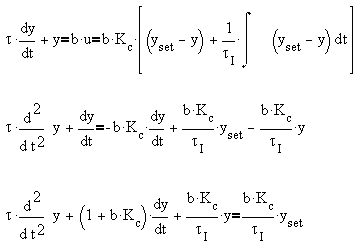-
Connect the feedback to an on-off controller:
If process gain is positive: U = uo+h (if y<yset), uo-h (otherwise)
If process gain is negative: U = uo-h (if yyset) uo+h (otherwise)
-
Wait until the process attains a limit cycle
-
Using the amplitude of the limit cycle, a, evaluate the approximate ultimate
gain, Ku = (4/p)(h/a). Also record the period
of oscillation of the limit cycle as the ultimate period, Pu.
-
Using the calculated Ku and Pu, use the Ziegler-Nichols tuning table.

